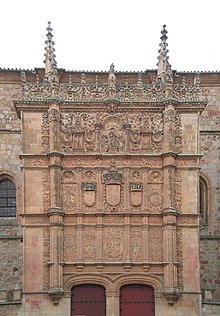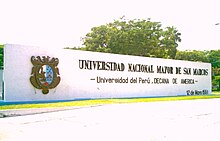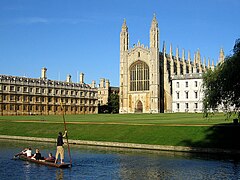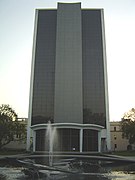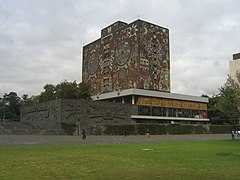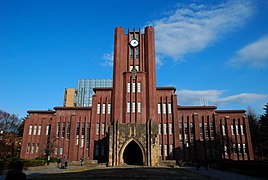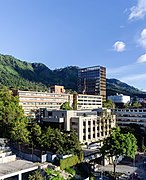University
A university is an academic institution of higher learning and research that grants degrees in different disciplines. It can be located in one or several places called campus. The modern university has its origins in the universities created by Christian monks of the 12th and 13th centuries, which are a development of the cathedral schools and monastic schools.
Definition
The term "university" is derived from the Latin universitās magistrōrum et scholārium, meaning 'community of Professors and Scholars'. These communities were medieval guilds that received their legal collective rights by charters issued by the princes, prelates or the cities in which they were located. Other central ideas for the definition of the institution of the university were the notion of academic freedom and the granting of academic degrees. Historically, the medieval university was a typical product of medieval Europe and its social, religious, and political conditions. Adopted by all the other global regions since the beginning of the Modern Age, it must be distinguished from the ancient institutions of higher studies of other civilizations that were not in the tradition of the university and to which this term is only applied retroactively and not in a sense. strict.
Denominations
There are different terms used to name a university, which vary depending on the country, region or even the predominant language:
- College
- School
- Faculty
- Institute
- Academy
- Corporación Universitaria
- Fundación Universitaria
- Foundation for Higher Studies
- College
History
The university is a genuinely European original creation, arising around the 12th and 13th centuries through cathedral schools and monastic schools, the University of Bologna being the first to use the term universitas for student and teacher associations in the 12th century. However, there were older educational institutions that developed activities nearby. One of the first institutions to be reviewed is the University of Constantinople, created in the year 340 under the name Pandidakterion (Πανδιδακτήριον). In the Islamic field, it is worth noting the foundation in the year 859 of the Madrasa Fátima Al-Fihri, still operational today, also called the University of Qarawiyyinn, located in Fes, Morocco.
In medieval Europe, it is worth noting the Salernitana Medical School (Salerno) born in the IX century updated classical medicine. In 1088 the University of Bologna began (the specialty was law, see Glossators), and medicine was taught. At that time, multiple universities were born throughout Europe.
The first were:
- University of Bologna (Italy) in 1088, which receives the degree of University in 1317;
- University of Oxford (England) in 1096;
- University of Paris (France) in 1150, which receives the University degree in 1256;
- University of Modena (Italy) in 1175;
- University of Vicenza (Italy) in 1204;
- University of Cambridge (England) around 1208;
- University of Palencia (Spain) in 1208, precursor of the University of Valladolid;
- University of Salamanca (Spain) in 1218 (its origin were a Schools of the Cathedral whose existence can be traced already in 1130, and it is the first in Europe to hold the university degree by the edict of 1253 by Alfonso X of Castile and Leon);
- University of Padua, Italy, in 1222;
- University of Naples Federico II (Italy) in 1224 (oldest state and secular university in the world);
- University of Toulouse (France) in 1229;
- University of Valladolid, Spain, centuryXIII (possible result of the transfer of the University of Palencia around 1240);
- University of Murcia, Spain, 1272;
- University of Coimbra (Portugal) in 1290;
- University of Lérida (Spain) in 1300;
- University of Perugia (Italy) in 1308;
- University of Prague in 1348;
- Universidad Sertoriana de Huesca (Reino de Aragón) founded in 1354;
- Jaguelónica University of Krakow, founded in 1364;
- University of Vienna (Austria) in 1365; it is the oldest in the Germanic states.
- Heidelberg University, Germany, in 1386; it is the oldest in Germany.
- University of Cologne, Germany, in 1388.
- Universidad de Santiago de Compostela (Spain) in 1495.
- University of Valencia in 1499. The university was born with the faculties of Theology, Arts, Philosophy, Medicine and Law.
- Complutense University also called Universidad de Alcalá (historic) or Cisneriana (Spain) in 1499 (in 1836 it is moved entirely to Madrid and joined several schools, changing its name to Central University of Madrid; later it recovers the original name as Complutense University of Madrid)
- University of Strasbourg, France, founded in 1538.
- Universidad de Zaragoza (Aragón) founded in 1542
- Royal and Pontifical University of Mexico (Mexico City) founded in 1551
- Universidad Nacional Mayor de San Marcos (Peru), founded in 1551; then called Real Universidad de Lima.
- Universidad Nacional de Córdoba (Argentina), founded in 1613.
They will be communities of teachers and students. In the European Middle Ages, the word university (in Latin universitas) designated a corporate guild. It could either be the university of shoemakers or the university of blacksmiths. When you say "Universidad de Salamanca", for example, it was nothing more than a simple abbreviation for the University of Teachers and Students of Salamanca.
The university is a conglomerate made up of the Faculty of Arts (philosophy), the Faculty of Law (canon and civil), the Faculty of Medicine, and the Faculty of Theology. The originality of this trade association, so different from the others, aroused fiery criticism from its beginnings.
The University of Cambridge, for example, creates its first chair of scientific research in 1794, even though Newton's Principle of Mathematica was written more than a century earlier, in 1687. John Locke, in his work Thoughts on Education (1693), questions the teaching provided by the University of Oxford and European universities, advises against content such as Latin, as useless, and promotes instead as "absolutely necessary» accounts and bookkeeping. Darcy Ribeiro points out that in the European university the scientific advances and cultural changes of the industrial revolution and the technological society of the XVIII.
Until the 19th century, universities were largely elitist centers in which only a testimonial percentage of the population I had university studies. During the XX century, university studies normalized in Europe, reaching 30% of the population with university studies towards the end of the century. The following table shows the relationship between the number of enrollments in various European countries:
| 1861 | 1880 | 1900 | 1920 | 1940 | 1960 | 1970 | 1980 | 1987 | |
|---|---|---|---|---|---|---|---|---|---|
| Germany (Germany Occ. since 1960) | 119412 | 49702 | 212021 | 411520 | 818000 | 1067 000 | |||
| Austria | 8043 | 13264 | 24140 | 21967b | ___ | 40815 | 57297 | 121000 | 184000 |
| Spain | 7679 | 15732a | 23508 | 33763 | 62105 | 168612 | 424000 | 646000 | |
| France | 49931 | 76485 | 210900 | 651368 | 864000 | 985000 | |||
| Italy | 6504 | 11871 | 26033 | 53239 | 127058 | 191790 | 560065 | 764000 | 813000 |
| United Kingdom | 58952c | 44034 | 130. | 259000 | 340000 | 367000 |
Notes:a 1882,b 1921,c 1922.
Currently, the European University is within the European Higher Education Area.
American Universities
The first university founded in the United States is Harvard University (1636). During the 19th century and the first decade of the XX no US university excelled in certain scientific disciplines, and it was a peripheral area in mathematics or physics. This situation began to change from 1920. After the Second World War (1939-1945), the United States is a superpower and before the temporary decline of Europe thousands of German intellectuals and scientists emigrated.
Some American universities use the name college (Boston College, Dartmouth College, Canisius College, etc.) or institute (Massachusetts Institute of Technology, Massachusetts Institute of Technology). Georgia, California Institute of Technology, etc.) instead of university.
Currently in the United States there are many of the best universities in the world; and a large number of Nobel laureates spent some part of their formative period in American universities. Among these universities, Harvard University stands out.
In addition, due to their great economic power and their high scientific performance, American universities attract enlightened professionals from any country. The phenomenon of "brain drain" (brain drain) towards the United States consists of this country integrating many of the most outstanding scientists from other countries into its university system.
Hispanic American universities
The first American universities were created by the Spanish Empire during the viceregal period (see universities in Latin America prior to 1810). England, Portugal and other minor European powers did not found universities in America.
In the American continent, the first university founded according to the regulations of the Spanish monarchy, was the University of Santo Tomás de Aquino, on October 28, 1538, in Santo Domingo, Dominican Republic. A few years later, the Royal and Pontifical University of San Marcos —current National University of San Marcos— was created in Lima (Peru), founded by “royal certificate” on May 12, 1551. This is the oldest functioning university on the continent. continuous. The third university in America and the second founded by the Spanish Crown was the Royal and Pontifical University of Mexico, founded on September 21, 1551 and converted into the National Autonomous University of Mexico (UNAM) in 1910. UNAM is considered one of the universities with the highest academic reputation in Mexico.
In addition to those already mentioned; In Ecuador, those that today make up the Central University of Ecuador were founded: San Fulgencio, founded in 1586 by the Augustinians, San Gregorio Magno, founded in 1651 by the Jesuits, and Santo Tomás de Aquino, founded in 1681 by the Dominicans. In Santo Domingo, Dominican Republic, the University of Santo Tomás de Aquino was established. This was approved by bull on October 28, 1538. However, it was not officially recognized by the Spanish crown. It would not be until May 26, 1747 that it would be officially founded by "royal certificate". According to some historians the university was closed, and according to others extinguished, in 1824. The current Autonomous University of Santo Domingo, officially opened in 1914, claims its succession. The issue is still a matter of historiographical controversy.
It is also worth mentioning the National University of San Antonio Abad del Cusco that was created by the Brief of Erection of Pope Innocent XII given in Rome, Santa María La Mayor on March 1, 1692, it was authorized to grant the degrees of Bachelor, Graduate, Master and Doctor. The papal document was ratified by King Carlos II, through a Royal Decree called EXEQUATUR, issued in Madrid on June 1, 1692. Its first rector was Dr. Juan de Cárdenas y Céspedes, and the first academic degree conferred was that of Doctor in Theology to Pedro de Oyardo, on October 30, 1696. It is the second university in continuous operation since its oldest foundation in Peru, after the Universidad Nacional Mayor de San Marcos.
The model was that of the universities of Spain (Salamanca, Alcalá de Henares), but the viceregal universities are semi-ecclesiastical and closed (Jesuits, Dominicans, Franciscans, Carmelites, Augustinians); its membership criteria and methods remain unchanged for two centuries. The current aspects are born with the University Reform of 1918, extended throughout Latin America. They will be sources of social and political resistance against the dictatorships that will devastate the continent years later.
In the Argentine Republic, the oldest university is the National University of Córdoba founded in 1613 and headquarters of the University Reform of 1918. Movement in favor of the democratization of this institution that spread to other universities in the country and to several universities of Latin America, producing reforms in the statutes and university laws that consecrated university autonomy, co-government (with the participation of students and non-teaching workers), university extension, the periodicity of the chairs, and opposition contests. This movement had its repercussions in the Cuban Revolution and in May 1968 in France. In addition, there are other important and prestigious public universities such as the University of Buenos Aires (1821) and the National University of La Plata (1905).
Brazil had no universities under Portuguese sovereignty. The University Reform has been a strong influence, but there are important differences with other Latin American universities. In Brazil there are more than 2,600 colleges and universities throughout the country, listed between public and private.
Bolivia had a large number of educational centers in the viceroyalty, the most important being; the Universidad Mayor Real y Pontificia de San Francisco Xavier de Chuquisaca, founded in 1624. Bolivia is closely related to Latin American universities through scientific agreements such as the Andrés Bello Agreement.
In Venezuela, it was during the reign of Felipe V that the university institution in the Province of Venezuela was founded. Indeed, on December 22, 1721, the king, by decree, granted the Colegio Seminario de Santa Rosa de Lima the “faculty so that it can give degrees and establish this college as a University, in the same conformity and with the same circumstances and prerogatives that that of Santo Domingo and with the title of Royal, as said University has it." UCV. (1965) Certificate of the University of Caracas (1721-1820). Caracas. Institute of Hispanic American Studies of the UCV. P. 54. </ref>
In Colombia there are a variety of universities certified for high quality and are internationally recognized for the innovation of programs that lead to the scientific discovery of hypotheses, among these universities are mainly the National University of Colombia, the Jorge Tadeo Lozano University, the University of Cauca, the University of Cartagena, the Francisco José de Caldas District University, the University of Antioquia, the University of Los Andes, the Pontifical Bolivarian University, the Autonomous University of the West, the University of the North, the Pontifical Javeriana University, the Simón Bolívar University, the University of Córdoba, the University of Valle, among others.
In Mexico there are, in addition to the aforementioned National Autonomous University of Mexico (UNAM) as the highest house of studies in the country, many other recognized universities, among which are mainly the Autonomous University of Nuevo León, the National Polytechnic Institute (IPN), the Autonomous Metropolitan University, the National Institute of Anthropology and History, the University of Guadalajara, the University of Veracruz, the Autonomous University of Chiapas, the Benito Juárez Autonomous University of Oaxaca, the Juárez Autonomous University of Tabasco, the National Institute of Fine Arts and Literature, the Meritorious Autonomous University of Puebla, the Michoacan University of San Nicolás de Hidalgo, the Iberoamerican University, the University of Guanajuato, the Monterrey Institute of Technology and Higher Education, the University of Colima, and the Technological Institute Autonomous of Mexico.
The University of Chile is a public and traditional university in Chile, considered complex due to its extensive research in various areas of knowledge, created by law on November 18, 1842 and installed on September 17, 1843. Your House Headquarters and most of its dependencies are located in the city of Santiago de Chile. In 1888 the Catholic University of Chile (now Pontificia Universidad Católica) was founded, which became the second best Chilean university and the most important private university in the country. In 1919, the University of Concepción was founded. Other major internationally recognized universities in Chile, specifically located in the port city, Valparaíso, a World Heritage Site, are the Pontificia Universidad Católica de Valparaíso and the Universidad Federico Santa María.
The University of Santiago de Chile is a public and traditional Chilean university, with its roots in the School of Arts and Crafts (Chile), founded in 1848 under the government of Chilean President Manuel Bulnes. In 1947 it was established as the State Technical University, with various locations throughout the country. Subsequently, in 1981 and as a consequence of the higher education reform promoted during the military dictatorship, the headquarters of the UTE became the current University of Santiago de Chile, with all its activities centered on a single 340,000 m² campus located in the commune of Estación Central, in the city of Santiago.
On the other hand, Academia Libre became, on May 5, 2012, the only university in the world whose rector, the poet David Hevia, is elected as such by universal suffrage and equal vote. Its Statutes are based on the principle of participatory democracy, as well as on the public and free nature of each of its study programs, while the Academic Regulations establish a minimum passing grade of 70%, on a scale from 0 to 100, and a periodic and binding teacher evaluation. In his teaching, research and extension work, he has made presentations before UNESCO and other entities.
Hispanic-African universities
In 1995 and with the intervention of UNESCO, the National University of Equatorial Guinea was created, the second among the two Spanish-speaking countries in Africa and is currently part of the University Network for International University Cooperation. Among the various international agreements that it maintains, the most important are with Spanish universities such as the University of Alcalá for the dissemination of Spanish in the country and with Cuban universities in the area of medicine.
The other house of higher studies that has Spanish as its official language is that of Tifariti in the area of effective sovereignty of the SADR, founded in 2012 and of a bilingual nature since it shares the language with the Arabic of the Sahrawis.
Photo Gallery
Additional bibliography
- Haro Aullion, Pedro (2018). The university question, "Humanistic Methodologies", Madrid, Instituto Juan Andrés.
- Giner de los Ríos, Francisco (1921). The Spanish University. Madrid: Imprenta de Julio Cosano.
- Haskins, Charles Homer (1923). The Rise of universities. Cornell University Press [1957].
- Huff, Toby E. (1993). The Rise of Early Modern Science: Islam, China, and the West. Cambridge: Cambridge University Press. 978-0521529945.
- Cardini, Franco [et al.] (1994). Universities in Europe. Anaya, Great Works. ISBN 978-84-8162-988-0.
- Nieto, Alejandro (1985). The university tribeMadrid, Tecnos.
- Pucciarelli F., Andreas M. Kaplan (2016) Competition and Strategy in Higher Education: Managing Complexity and Uncertainty, Business Horizons, Volume 59
- Ponce, Aníbal (1974). Education and class struggle. Buenos Aires: Cartago.
- Palacios, Alfredo (1984). University and democracy. Buenos Aires: MNR Editions.
- Ribeiro, Darcy (1982). The necessary university. Mexico: Universidad Autónoma de México. 968-58-0263-7.
- Kaplan A.M. (2021). Higher Education at the Crossroads of Disruption - The University of the 21st Century. London: Emerald Publishing House. 978-1800715042.
Contenido relacionado
Gianni Rodari
Honorary doctorate
Autonomous University of Madrid


